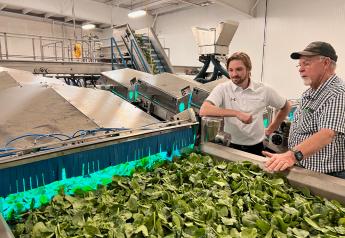Part 2 — Another wild ride for trucking rates

For produce shippers and truck carriers, 2021 is one for the record books.
The Packer spoke on May 25 with Dean Croke, Boston-based principal analyst for DAT Solutions, about the unprecedented truck rate increases the industry has seen far, and what may be around the corner.

The Packer: We hear about the driver shortage. Do you think the higher markets and the higher rates will draw more people into the business?
Croke: There’s been a lot of conjecture about how real (the driver shortage) has been in previous years. There’s no question (now) that there’s a shortage of good professional drivers. The industry does a really bad job at taking a new hire and turning it into a career. There’s a massive void in the middle there were a lot of guys are steering a truck between other jobs. For those that make it a career and a profession, it is generally in the smaller fleets, where you are going to find more tenure and more professional operators, especially in the produce sector. That is sort of normally how it pans out but during the pandemic, something broke, where we’ve now got a really big shortage of drivers and trucks. It’s a supply problem, with demand racing ahead and supply can’t catch up. Because normally truckers today, if they could see trucks, they would buy them. They are waiting up to 12 to 15 months on new truck builds now and trailers are much longer (waits).
On the big fleet side that do all the big contract volume, the large fleets that have the student training school model, schools were shut down (during the pandemic). When they reopened, they had the physical distancing problem. For a good part of quarters two and three last year, they physically couldn’t put as many students into a room. they had a throughput problem. And they’re only today about 60% to 70% capacity.
Now, that’s not the worst of it. I’ll come back to the lumber shortage and the pallet problem you talked about last week, because what’s happening is this compounding effect as one thing sort of breaks, it breaks another thing in the supply chain. The housing boom, the urban flight, the lumber shortage and now we can’t find pallets to move produce.

With drivers, we had a driver supply problem because of the training schools and because all the (licensing offices) were shut down and by appointment only. You now have got two to four months before you can get your CDL license after you’ve been through the school.
We’ve got more freight to haul but we’ve got less drivers, and less trucks. And what’s coming out of that are these record high spot rates. It’s not demand driven, it’s supply driven. And it’s two factors that are working at the same time, the equipment shortages and the driver shortages.
Then if you look at the broader macro picture, it’ll take time before every industry finds enough workers. Everywhere you go, there’s a labor shortage. The federal government’s trying to get people back into the workforce, and it’ll take time for every industry to be able to find enough people to meet the demand, not just for trucking. But in trucking, it is just exacerbated in what was already a tight market.
I’ve always theorized that these high spot rates we see in refrigerated loads around July 4 will go on much longer, because there’s going to be a longer tail to the produce season this year, because of the delay in restaurants and foodservice opening back up.
The Packer: What do you think is the best approach for shippers (looking to secure transportation)? As they look at truck contracts, is there a certain time of year that this is typically addressed?
Croke: Because capacity is tight, shippers have been doing a lot of mini bids. They will carve out part of their business in a region and try and do a shorter-term contract negotiation for three months on a handful of lanes. Traditionally, though, it’s an annual bid that’s done late in the year in quarter three or quarter four. The rates negotiated for January 1 this year, when they came into effect in the routing guides in the truck management software systems, they were negotiated three or four months earlier.
The Packer: As you look at the rest of the year, what would you advise the industry about what might be ahead, and one approach to deal with it?
Croke: Capacity is going to be the biggest challenge carriers face. Shippers and receivers can do a couple of things. One is obviously to communicate. Treat drivers extremely well. Work really closely on appointment times, pick-up and delivery windows, because there’s a lot of capacity and hours left on the table because of delays. Shippers and receivers could do a really good job in getting trucks and trailers off docks much quicker. But then the other part though, is to find ways to invent capacity. The average truck is only running 6.5 to 7.5 hours per day (out of 11 allowed), because a lot of fleets don’t run their 11 hours now. A smaller owner-operator running produce, he’s got to run up right to the max because he’s experienced, he’s got a deadline.
In the average fleet though, especially the larger fleets, seven hours a day would be a big day for them. Because there’s lack of tenure, there’s lack of understanding of the industry. There’s inefficiency, and lack of parking. A lot of these guys are trying to find a parking spot at four and five in the afternoon. And they trade off the rolling time up to 11 hours with trying to find a parking spot for the night. There’s a lot of things working against the industry. What I say is to find ways to help carriers be more productive and invent capacity.
When I say invent capacity, pick all the times to load and unload when the trucking industry is really quiet, like on weekends. Grower-shippers could do a lot more by helping carriers optimize their fleets, by getting more productivity into the seven-day week
I think tight capacity is going to be with us through year end, there’s no doubt about that, because of the labor shortage that every industry is facing. And it will be well into quarter one of next year before I think we start to see any form of equilibrium in the market.
You think about the pent-up demand that exists in the market for all sorts of things, I think we will see a lot more demand for trucks and drivers for the rest of the year.
Related articles:
Packer interview: Michelle Grainger of the North Carolina SweetPotato Commission
Bowery Farming appoints Google vet Injong Rhee as chief tech officer
Aidan Mouat on Hazel Technologies Inc. finalizing $70 million in Series C financing
Reimagining industry engagement







